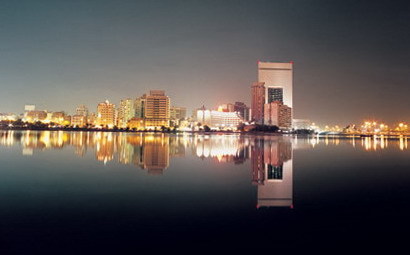
Saudi Arabia’s economy is set to grow this year at the slowest pace since 2002 as the oil-price plunge drains the kingdom’s finances, according to projections released by the International Monetary Fund and HSBC.
Economic growth in the world’s largest oil exporter will slow to 1.2%, the IMF said in an update to its World Economic Outlook. That’s still more optimistic than HSBC, which expects the biggest Arab economy to expand 0.8%. Growth was 3.4% in 2015.
The prolonged oil slump saddled Saudi Arabia with a budget deficit of about $98billion last year, pushing officials to cut spending, consider an international sovereign bond sale and cut energy subsidies.
The price of Brent crude has fallen by more than 40% since October, when the IMF last released forecasts for the kingdom and said growth would be 2.2% this year.
The fundamentals “seem to point to a low-for-long scenario for oil,” Maury Obtsfeld, director of the IMF’s research department, said.
“With Iranian oil coming online, with the resilience in the shale extraction industry in the US, the possibility of shale extraction elsewhere, it’s hard to see oil going back to the $100 a barrel level anytime soon,” he said.
Saudi officials have repeatedly said the economy is strong enough to weather the lower oil prices
The benchmark Tadawul All Share Index gained 4% Tuesday to close at 5,746.4 in Riyadh as oil rebounded from a 12-year low. The measure has lost 32% over the past 12 months.
The fall in oil prices is also forcing other oil producers in the Gulf Cooperation Council countries to cut subsidies and scale down public projects. The UAE, the second-largest Arab economy, scrapped fuel subsidies in August and reined in increases in public wages. HSBC trimmed its growth forecast for the 7-state federation to 2.3 percent from 2.4 percent.
HSBC cut projections elsewhere in the Persian Gulf. Qatar is now seen expanding 3.6 percent versus an initial estimate of 5.5 percent. Oman’s output forecast was reduced to 0.5 percent from 1.4%, and Kuwait’s was lowered to 1.9% from 2.1 percent. Bahrain remained unchanged at 1.8 percent.
The kingdom plans to cut the budget deficit to 326 billion riyals ($87 billion) in 2016. The 2015 deficit came in under target at 367 billion riyals or 16%t of gross domestic product, according to the National Bank of Abu Dhabi. The median estimate of 10 economists was a shortfall of 20% of GDP in 2015 and 13.5% this year, according to data compiled by Bloomberg.
The country’s net foreign assets dropped for the 10th month in a row in November as it dug into its savings to finance the budget. The assets have tumbled $109billion since August 2014. The government may issue international bonds in addition to local debt in 2016, according Finance Minister Ibrahim al-Assaf.
Saudi Arabia relied on oil for 73% of its revenue last year, a level of dependence the government is keen to reduce. Among other measures, it’s considering new forms of taxation and privatizing state assets, including an initial public offering for Saudi Arabian Oil Co., Deputy Crown Prince Mohammed bin Salman told The Economist this month.
“However, even allowing for significant reductions in outlays this year, we expect weak oil prices to leave Saudi Arabia with a budget deficit of well over 10% of GDP, suggesting the Kingdom faces multiple years of spending cuts and austerity as it seeks to rebalance public finances,” HSBC economists Simon Williams and Razan Nasser wrote in a report.